#aratinga weddellii
Explore tagged Tumblr posts
Text
A Comprehensive Guide to the Dusky Conure: The Dusky-Headed Conure

The Dusky Conure (also known as the Dusky-Headed Conure) is a delightful and charming parrot species native to South America. Known for its striking appearance, playful nature, and intelligent personality, this small but captivating bird has been gaining popularity as a pet among bird enthusiasts. Whether you are considering adopting a dusky conure or simply wish to learn more about them, this blog will provide you with a detailed look into their characteristics, care requirements, and fascinating behaviors.
What is a Dusky Conure?
The Dusky Conure is a member of the Aratinga genus, a group of small to medium-sized parrots known for their vibrant colors and engaging personalities. Native to the lowland forests of the Amazon Basin, the dusky-headed conure, or Aratinga weddellii, is primarily found in countries like Brazil, Bolivia, and Argentina.
Physical Description
The Dusky Conure is named for its distinct dark-colored head, which can range from slate-grey to charcoal, often with slight tinges of green. Their plumage is predominantly green, with a light greenish-yellow hue on their underparts, and they have slightly darker wings and tail feathers. They typically have a medium size, with an average length of around 12 to 14 inches (30 to 35 cm) and weighing between 80 to 120 grams.
One of the most interesting aspects of the dusky-headed conure’s appearance is its large, expressive eyes, which can appear almost "adorable" in their intensity. Their beaks are strong and curved, designed for cracking nuts and seeds, and their feet are zygodactyl (two toes facing forward and two backward), allowing for an excellent grip.
Behavior and Temperament
Dusky conures are known for being energetic, playful, and friendly birds, often forming strong bonds with their human caregivers. They are highly intelligent and social, needing regular mental stimulation to stay happy. They are also quite vocal and love to interact with their surroundings, often mimicking sounds and sometimes even human speech.
Despite their playful demeanor, dusky-headed conures can sometimes be a bit stubborn. However, with consistent training and positive reinforcement, they can learn tricks, follow commands, and behave in a well-mannered manner. Keep in mind that like many parrots, they may become territorial or aggressive without proper socialization, especially if they feel neglected.
The Dusky Conure's Lifespan
A Dusky-Headed Conure can live for up to 25 years or more in captivity, provided they are given the right care, diet, and attention. Their longevity is a testament to their resilience and adaptability in various environments, both wild and domestic.
Dusky Conure Care: Essential Tips for Pet Owners
If you’re thinking about bringing a Dusky-Headed Conure into your home, it's important to understand the responsibilities that come with caring for one of these fascinating birds. Here are some key considerations to ensure a happy and healthy life for your dusky conure.
1. Housing and Environment
Dusky conures are highly active birds, so providing them with a spacious cage is essential. The cage should be at least 24 inches wide, 24 inches deep, and 30 inches tall to give them enough room to move around comfortably. The bars should be no wider than ½ inch to prevent escape or injury.
It’s also essential to place the cage in a well-lit area, preferably near family activity, so the dusky headed conure feels included in household life. However, avoid placing the cage in areas with drafts, extreme temperatures, or direct sunlight. Additionally, provide a variety of perches made from different materials (wood, rope, and cement) to keep their feet healthy and provide variety.
2. Diet and Nutrition
A balanced diet is crucial for the health and well-being of your Dusky Conure. Their diet should consist of a high-quality pellet mix designed for parrots, supplemented with fresh fruits, vegetables, nuts, and seeds. They especially enjoy foods like apples, carrots, grapes, leafy greens, and berries.
Ensure that your dusky conure has access to fresh water at all times and that they avoid high-fat or sugary foods that can lead to obesity or other health problems. It's also important to limit high-sodium foods, such as salty snacks, which can be harmful to birds.
Be cautious when introducing new foods and make sure they are safe for birds. Some foods, like avocado, chocolate, and caffeine, are toxic to parrots and should be avoided at all costs.
3. Socialization and Interaction
Dusky-headed conures thrive on social interaction and need regular attention from their owners to feel happy and secure. They are highly intelligent and can get bored easily if not mentally stimulated. Regular interaction, training sessions, and time spent outside the cage are essential to prevent destructive behaviors and ensure they remain well-adjusted.
These birds often form deep emotional bonds with their owners and can be very affectionate, even seeking out cuddles and attention. However, if they feel neglected or bored, they might develop undesirable behaviors like excessive screeching or feather plucking.
4. Exercise and Mental Stimulation
Given their playful nature, dusky-headed conures require daily exercise to stay healthy. Allow them to fly or explore outside their cage in a safe, enclosed area. You can also offer them toys like bells, ladders, swings, and puzzle toys to keep their minds active. A lack of mental stimulation can lead to destructive behaviors like chewing furniture or self-mutilation.
Interactive toys that require problem-solving or foraging are great choices to keep them occupied. Regular training sessions using positive reinforcement can also be beneficial in providing mental stimulation while strengthening the bond between you and your bird.
5. Grooming and Hygiene
Dusky conures are generally clean birds that do a lot of preening to maintain their feathers, but they will still require occasional grooming. This includes nail trimming, beak maintenance, and occasionally bathing. Provide your bird with a shallow dish of water or a gentle misting to encourage bathing, which will help keep their feathers healthy.
Regularly check their beak and nails to ensure they are not overgrown, as this can affect their ability to eat and perch properly. If you're unsure about how to trim a conure's nails or beak, consult with a professional avian veterinarian for advice.
Common Health Issues in Dusky Conures
Like all pets, Dusky-Headed Conures can suffer from certain health issues. It’s important to be aware of potential problems to catch them early and seek treatment from an avian vet.
1. Obesity
Obesity is a common concern for pet birds, including dusky conures. Overfeeding high-fat foods or a diet lacking variety can contribute to this condition. Ensure that your conure is getting the proper balance of nutrients and is not being overfed.
2. Feather Plucking
Feather plucking is a behavioral problem that can occur in dusky conures, often caused by stress, boredom, or lack of socialization. If you notice that your bird is plucking its feathers excessively, it's important to identify the underlying cause and address it promptly.
3. Respiratory Issues
Conures are sensitive to airborne toxins, including smoke, cleaning chemicals, and strong perfumes. Exposure to these substances can lead to respiratory infections or irritations. Be sure to provide a clean, safe environment for your bird and avoid using toxic chemicals around them.
4. Psittacine Beak and Feather Disease (PBFD)
PBFD is a viral disease that affects parrots, including dusky-headed conures. It weakens the immune system, leading to feather loss, beak deformities, and other health complications. Regular vet checkups are essential for early detection.
Dusky Conures as Pets: Why They Are Perfect for the Right Owner
A Dusky Conure can be an excellent pet for the right owner, especially for those who are prepared to meet their physical, emotional, and mental needs. Their playful and affectionate nature makes them wonderful companions, and their intelligence allows for a rewarding training experience. However, like all parrots, they require time, patience, and a commitment to their care.
If you're an experienced bird owner or willing to dedicate time to their care and socialization, a dusky conure can be a great addition to your family. Their engaging personality, combined with their striking beauty, makes them a joy to have around.
Conclusion
The Dusky Conure, or Dusky-Headed Conure, is a beautiful and intelligent parrot species that can make a wonderful pet for the right owner. With their striking appearance, playful behavior, and affectionate nature, these birds have earned their place in the hearts of many bird lovers. If you are considering bringing one into your home, be prepared to provide them with plenty of attention, socialization, and care. With the right environment, diet, and training, your dusky conure can thrive and be a loving, lifelong companion.
1 note
·
View note
Text
Aratinga
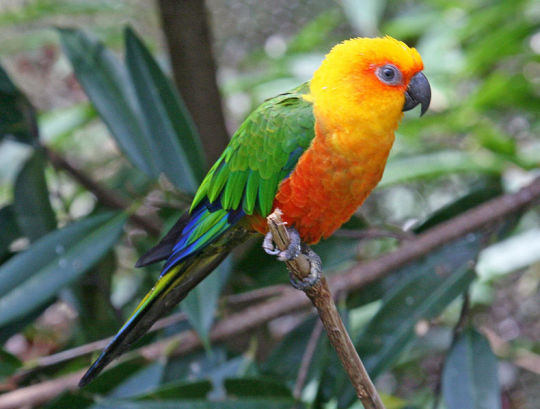
Jenday Conure, by Dick Daniels, CC BY-SA 3.0
PLEASE SUPPORT US ON PATREON. EACH and EVERY DONATION helps to keep this blog running! Any amount, even ONE DOLLAR is APPRECIATED! IF YOU ENJOY THIS CONTENT, please CONSIDER DONATING!
Genus Name: Aratinga
Status: Extant
First Described: 1824
Described By: Spix
Classification: Dinosauria, Theropoda, Neotheropoda, Averostra, Tetanurae, Orionides, Avetheropoda, Coelurosauria, Tyrannoraptora, Maniraptoriformes, Maniraptora, Pennaraptora, Paraves, Eumaniraptora, Averaptora, Avialae, Euavialae, Avebrevicauda, Pygostylia, Ornithothoraces, Euornithes, Ornithuromorpha, Ornithurae, Neornithes, Neognathae, Neoaves, Inopinaves, Telluraves, Australaves, Eufalconimorphae, Psittacopasserae, Psittaciformes, Psittacoidea, Psittacidae, Arinae, Arini
Referred Species: A. solstitialis (Sun Conure), A. maculata (Sulphur-Breasted Parakeet), A. jandaya (Jenday Conure), A. auricapilla (Golden-Capped Parakeet), A. nenday (Nanday Parakeet), A. weddellii (Dusky-Headed Conure), A. vorohuensis
It is difficult to really pick a favorite genus of modern day bird to do on my birthday - so many parrots, passerines, and penguins to choose from! But I think I have to go with Aratinga, a genus of Conures that includes the charismatic Sun and Jenday Conures. This genus has a fossil record, with A. vorohuensis being found in Argentina. It was discovered in the Vorohué Formation, a location on the coast of Northwestern Argentina, and it lived about 3 million years ago, in the PIacenzian age of the late Pliocene of the Neogene. Whether or not this is when Aratinga evolved as a genus is uncertain, as the bird is not particularly interesting or unique; in fact, it resembles A. nenday extensively, so it’s difficult to pin point when this genus first evolved - but, at the least, it was no later than the Pliocene, and it probably originated in South America.
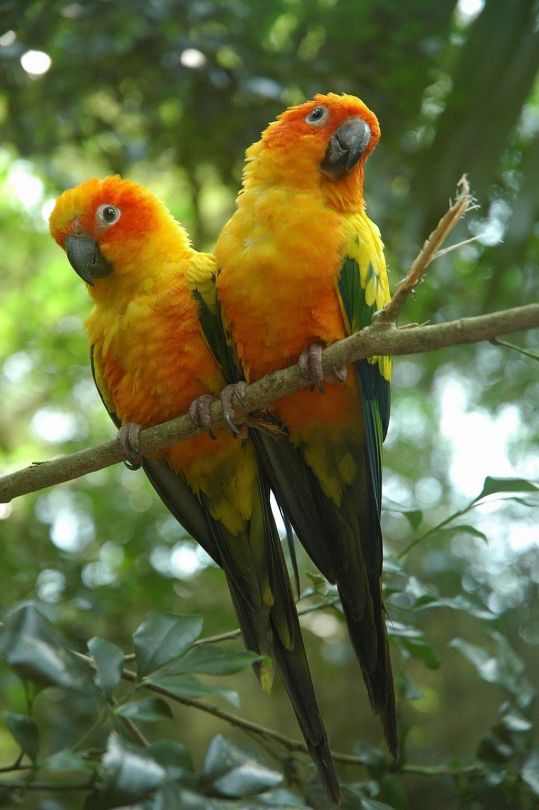
Sun Conure, by Wayne Deeker, CC BY 3.0
The Sun Conure, A. solstitialis, is arguably the most famous species of the genus, being often kept as a pet bird. However, it is endangered, due to loss of habitat and excessive catching for the aforementioned pet trade (making it very important that, if you want a pet Sun Conure, you get it from a shelter!) Bans imposed that stop the importation of parrots into the USA has lead to more breeding in captivity, however illegal trade still occurs, and capture of wild birds is still a serious threat, leading to its endangered status. Captive breeding does, however, ensure the continuation of the species. They are yellow birds, with red around the face and belly, and green and blue feathers on the wings. Juveniles are mostly green, with the other coloration attained as it grows. They’re usually around 30 cm long.

By Chris Williamson, CC BY 2.0
Curious and brightly colored birds, they live in a small region of North-Eastern South America - Braizil, French Guiana, Guyana, and Suriname. There have also been sightings of it in Venezuela. They live in tropical habitats, mostly humid tropical forests though they will cross savannah and coastal forests in order to get from habitat to habitat, and they inhabit fruiting trees and palm groves. They are social birds, living in large flocks of 20 to 30 individuals, and will squawk and scream loudly when separated in order to return to the flock. They’re quiet when feeding, but vocal in flight, and travel many miles in a day. They also have a variety of physical displays with one another, and they feed, rest, preen, and bathe during daylight. They can use their beaks to move through the trees as well, and they use their feet to examine the world, like we do with our hands.

By Brian Gatwicker, CC BY 2.0
Sun Conures nest in palm cavaties, and when they’re molting, they’re uncomfortable and irritable. They thus bathe and seek out rain and humidity in order to allow the feathers to come in more easily. They feed on fruits, flowers, berries, blossoms, seeds, nuts, and insects in the wild, as well as cactus fruit and even agricultural pests. They form monogamous breeding pairs at about 4 to 5 months of age, and they feed and groom each other before breeding. They mate for up to three minutes and are then affectionate with each other. They nest in trees and palms, and lay 3 to 4 eggs per clutch. The females incubate the eggs from 23 to 27 days, and males protect the nest. The chicks are dependent on their parents until 8 weeks after hatching, and they become independent after 9 to 10 weeks. Though they can form pairs early on, but are only really sexually mature at about 2 years of age, and live up to 30 years.
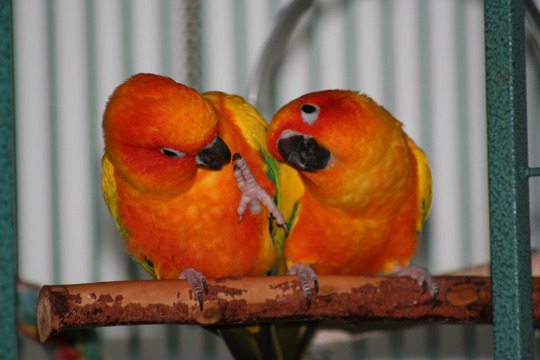
By Lionpro2006, CC BY 2.0
Their behavior is very poorly known in the wild, and most of our knowledge about them comes from their behavior in captivity. In captivity, they can learn to speak and perform tricks to a moderate degree. They feed on many different types of plants, and use cuttle bones or other calcium-rich substances to obtain calcium in their diet. They are very loud for their size and are very curious, so they require a lot of attention - but they can also be very loving and cuddly, and can be friendly towards those they know well. They like to listen to music, and can dance and sing along with. They chew on a lot of things and need toys to chew as pets, and they require extreme attentiveness in order to make sure they don’t escape, bite something they shouldn’t, or otherwise harm themselves.

Sulphur-breasted Parakeet, by Sidnei Dantas, CC BY 2.0
The Sulphur-Breasted Parakeet, A. maculata, resembles the Sun Conure extensively. It used to be two different species, A. maculata and A. pintoi, but those were since combined. It has been reported around the Amazon river, but it’s status as its own species separate from the Sun Conure is relatively new, and so much of its behavior and range is unknown. It is thought, however, to be of Least Concern in terms of its conservation status. They have more green feathers on the ring and greyish eye-rings in the wild, though it can fade to white in captivity.
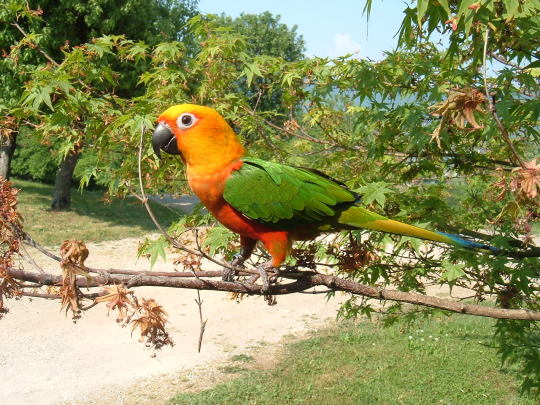
Jenday Conure, by Giannizzzero, in the Public Domain
The Jenday Conure, A. jendaya, is my favorite species in the genus, and thus my favorite species of modern-day dinosaur. It is small and long tailed, with a reddish orange body, orange cheeks, a black bill, and green and blue wings and back. It’s tail feather ends are tinged blue, and it’s about 30 cm long. it has a loud and shrill call, and is found primarily in Brazil, in lowland woodlands and palm groves. They feed on mangos, cashews, apples, and nuts, as well as human crops, which often leads to them being considered pests. They nest in tree hollows, about 15 meters from the ground, and the young are fed by both parents.
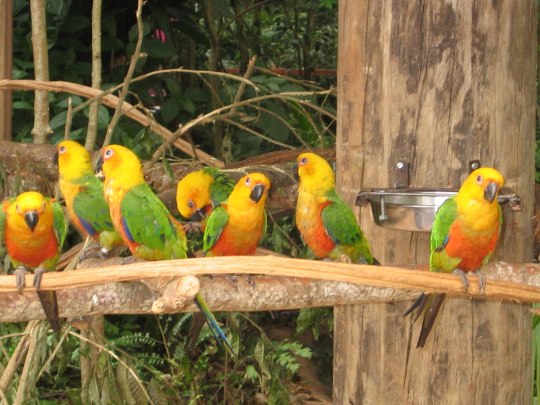
By Frank, CC BY 2.0
Jenday Conures are not endangered, and the trade and export of them is forbidden. Though they are not endangered and have a wide range, they are fairly scant in their ranges, and are rare to spot. They are often called the flaming conure, due to their bright red feathers, and are often kept as pets. They are intelligent birds and mimic sounds well, and are very social, living in large flocks in nature. They are very affectionate and playful birds, and are also extremely curious, so much like the Sun Conure, when kept as a pet they require extensive supervision.
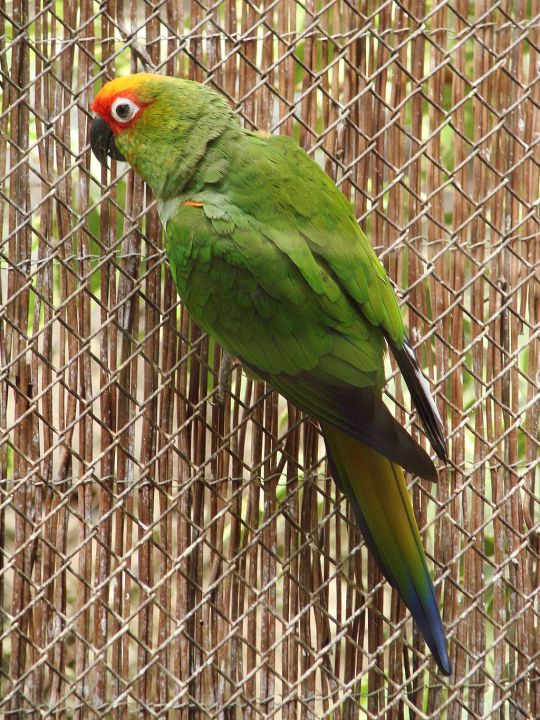
Golden-Capped Parakeet, by Guérin Nicolas, CC BY-SA 3.0
The Golden-Capped Parakeet, A. auricapillus, is another species of this genus, found in Brazil and Paraguay. It typically lives in tropical and subtropical dry forests and lowland forests, savanna, and plantations. It is near threatened due to habitat loss. It is about 30 cm long and is mostly green, with an orange bell and red face, leading to its name.

Nanday Parakeet, by J. Patrick Fischer, CC BY 3.0
The Nanday Parakeet, A. nenday, is another species of the genus - maybe - it’s been placed in its own before and Aratinga in general is probably paraphyletic (meaning, it’s not a single clade, but rather bits and pieces of other bird clades). It is 32 to 37 cm long, making it longer than other species in this genus, and doesn’t seem to particularly resemble them to look at. It is mostly green and has a black facial mask and beak, and has black flight feathers. It’s tail is tipped in blue, and its upper chest is bluish-green. They feed on seeds, fruit, nuts, berries, flowers, and buds. They live in scrub forest and forest clearings, as well as savannas and pastures. They find holes in trees to nest in, laying three or four eggs, and they form large communal roosts. IN captivity, they much like their relatives require sufficient stimulation and observance - they are very good at escaping from their cages!
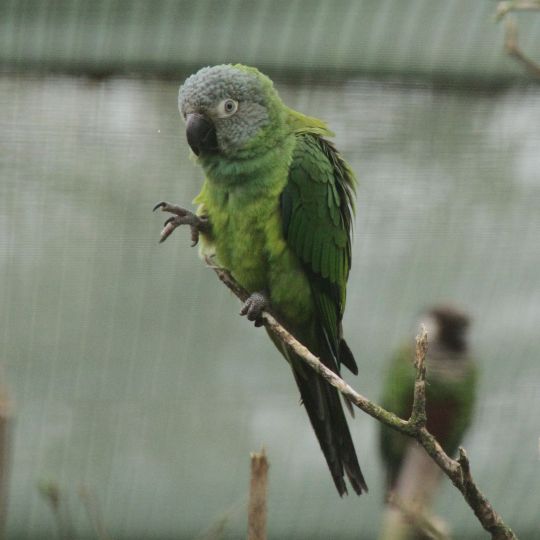
Dusky-Headed Parakeet, by David Long, CC BY 2.0
Finally, our last species, A. weddellii, is the Dusky-Headed Parakeet, or Dusky Conure. It is a green parrot from Brazil, Peru, and Venezuela, and is fairly common and not threatened in its conservation status. It is a small parrot, only about 25 to 28 cm long, and it is green in color with a grey head, a blue-tipped tale, and varying shades of green and grey on its body. They’re sometimes called mini macaws, because they have skin near their beak and eye like macaws. They are found in pairs and small groups, even flocking with other conures, with flocks having up to 100 members in times of plenty. They eat fruit, seeds, and flowers, and even insect larvae and mineral-rich soil and clay. They also are kept in captivity. They have life spans of anywhere from 25 to 50 years. As with all members of this species, they are energetic and playful birds.
Sources:
https://en.wikipedia.org/wiki/Aratinga
https://en.wikipedia.org/wiki/Aratinga_vorohuensis
Tonni, E. P., J. I. Noriega. 1996. Una nueva especie de Nandayus Bonaparte, 1854 (Aves: Psittaciformes) del Plioceno tardío de Argentina. Revista Chilena de Historia Natural 69: 97 - 104.
https://en.wikipedia.org/wiki/Sun_parakeet
https://en.wikipedia.org/wiki/Sulphur-breasted_parakeet
https://en.wikipedia.org/wiki/Jandaya_parakeet
http://www.parrotsecrets.com/Jenday-Conure/about-jenday-conure.php
https://en.wikipedia.org/wiki/Golden-capped_parakeet
https://en.wikipedia.org/wiki/Dusky-headed_parakeet
Shout out goes to @best-deodorant-for-men-blog!
#aratinga#conure#parrot#bird#dinosaur#birblr#palaeoblr#best-deodorant-for-men-blog#aratinga solstitialis#aratinga maculata#aratinga jandaya#aratinga auricapilla#sun conure#jenday conure#aratinga nenday#aratinga labati#aratinga weddellii#dinosaurs#biology#a dinosaur a day#a-dinosaur-a-day#dinosaur of the day#dinosaur-of-the-day#science#nature#factfile#Dìneasar#דינוזאור#डायनासोर#ديناصور
186 notes
·
View notes
Text
The Colorful World of Parrots: Spotlight on Senegal Birds and Dusky Conures

When it comes to feathered companions, few creatures are as enchanting as parrots. Their vibrant colors, intelligence, and playful nature make them a popular choice for pet owners worldwide. Among the numerous parrot species, the Senegal bird and the dusky conure stand out as two captivating options. This article will explore these birds in detail, examining their characteristics, care requirements, and market prices, particularly focusing on the Senegal bird price.
Discovering the Senegal Bird
A Glimpse into Their Background
The Senegal bird (Poicephalus senegalus) hails from the lush landscapes of West Africa, where it thrives in the savannas and wooded areas. Renowned for its vibrant green plumage, accented with brilliant yellow and orange underparts, the Senegal bird is not only visually stunning but also has a personality to match. With a size averaging between 9 to 10 inches, they fit comfortably into various living environments, making them suitable for both apartment and house living.
Personality Traits: The Joy of Companionship
Senegal birds are known for their affectionate and engaging nature. They form strong bonds with their owners and display a playful demeanor that can bring joy to any household. Their intelligence is remarkable; they can learn a variety of words and phrases, delighting their owners with vocal mimicry. Their playful antics, such as climbing and swinging, will keep you entertained for hours.
Lifespan and Health Considerations
With the right care, Senegal birds can live for 25 years or more. It is vital to provide them with a balanced diet, including high-quality pellets, fresh fruits, and vegetables, along with regular vet check-ups. Common health issues can arise from neglect, such as feather plucking or obesity, so ensuring their physical and mental well-being is crucial.
Introducing the Dusky Conure Bird
A Beautiful Companion
The dusky conure (Aratinga weddellii), also known as the dusky-headed conure, brings its charm from the tropical forests of South America, particularly Brazil. With an average length of 12 to 13 inches, this bird features a striking appearance characterized by its dark head, vibrant green body, and hints of yellow and blue in its plumage.
A Social Butterfly
Dusky conures are celebrated for their sociable and outgoing personalities. They thrive on interaction, both with their human companions and other birds. Their playful nature is infectious, often leading to spontaneous games of fetch or playful banter. These birds possess an innate curiosity, making them explore every nook and cranny of their surroundings.
Lifespan and Essential Care
Similar to the Senegal bird, dusky conures can enjoy a lifespan of 20 to 30 years with proper care. A varied diet consisting of pellets, fruits, and vegetables is crucial for their health. They require mental stimulation and social interaction to prevent boredom and associated behavioral issues.
Side-by-Side: Senegal Birds vs. Dusky Conures
Size and Aesthetic Appeal
While Senegal birds are smaller and more compact, dusky conures have a more elongated and robust body. The vivid colors of both species are a highlight, with Senegal birds flaunting a mix of green, yellow, and orange, while dusky conures display deep greens contrasted by their dark heads and colorful accents.
Behavioral Differences
Both species are playful and affectionate, but their temperaments differ slightly. Senegal birds can be somewhat reserved, forming strong attachments to specific individuals, while dusky conures tend to be more extroverted, enjoying the company of many different people.
Vocalization: A Matter of Volume
Both birds are capable of vocal mimicry, but the volume and style of their calls vary. Senegal birds produce softer, melodious sounds, while dusky conures can be quite loud and boisterous. If noise levels are a concern, it’s essential to consider these differences before making a choice.
The Economic Aspects: Understanding Senegal Bird Price
Evaluating Senegal Bird Price
When it comes to adopting a Senegal bird, potential owners should anticipate a price range between $300 to $700. Several factors can influence this price, including breeder reputation, the bird's age, and whether it has undergone any training.
Influencing Factors
Breeder Reputation: Birds from established breeders who prioritize health and socialization typically command higher prices. A reputable breeder ensures that the bird is well-cared for and socialized from a young age.
Color Mutations: Some Senegal birds display unique color mutations, such as cinnamon or lutino, which can significantly increase their market value. These rarer variations attract collectors and enthusiasts willing to pay more.
Training and Socialization: Young birds that have started to learn social behaviors or basic commands may also come with a higher price tag. Training plays a vital role in ensuring the bird adjusts well to its new home.
The Dusky Conure Price
Dusky conures generally range from $500 to $1,200. This price difference compared to Senegal birds can be attributed to their relative rarity and popularity.
Influencing Factors
Availability: Dusky conures are less frequently found in pet stores compared to other conures, leading to increased demand and higher prices.
Breeding Practices: Just like Senegal birds, purchasing from well-regarded breeders focusing on the bird’s overall health and well-being may lead to a higher cost.
Training and Preparation: Dusky conures that have been socialized and trained often come at a premium price due to their readiness for companionship.
Making the Right Choice: Factors to Consider
Assessing Your Lifestyle
Before welcoming either a Senegal bird or a dusky conure into your home, it’s essential to assess your lifestyle and environment. If you have a quieter household and prefer a bird that engages in softer vocalizations, a Senegal bird might be your best choice. On the other hand, if you enjoy a lively atmosphere filled with chatter and interaction, a dusky conure could be the ideal feathered companion.
Space Requirements
Both species require ample space to spread their wings and engage in natural behaviors. While Senegal birds can thrive in slightly smaller cages, dusky conures benefit from larger aviaries that allow for more play and exploration. Ensuring that your living space accommodates their needs is crucial.
Commitment and Care Needs
Owning a parrot is a long-term commitment. Both Senegal birds and dusky conures require daily social interaction, mental stimulation, and physical exercise. Assessing your ability to meet these needs will help you decide which bird may be the right fit for your home.
Building a Bond: Tips for New Bird Owners
Socialization Techniques
Both Senegal birds and dusky conures thrive on social interaction. Spending quality time with your bird, engaging in play, and offering praise when they mimic sounds or perform tricks can strengthen your bond. Positive reinforcement is key!
Enrichment Activities
Keeping your bird mentally stimulated is essential to their happiness. Provide toys, puzzles, and opportunities for foraging to encourage natural behaviors. Rotate toys regularly to keep your bird engaged and prevent boredom.
Diet and Nutrition
A balanced diet is critical for the health of both bird species. Offer a mix of high-quality pellets, fresh fruits, and vegetables to ensure they receive the necessary nutrients. Avoid feeding them avocados, chocolate, or caffeine, as these can be toxic.
Conclusion: Choosing Your Feathered Friend
In the enchanting world of parrots, both the Senegal bird and the dusky conure bird shine brightly with their unique characteristics. Understanding their care requirements, behavioral traits, and market prices—especially the Senegal bird price—can help potential owners make informed decisions.
Whether you choose the affectionate and playful Senegal bird or the lively and sociable dusky conure, both species promise to bring joy and companionship into your life. With proper care and attention, your new feathered friend can become a beloved member of your family for many years.
Final Thoughts
Taking the time to research and understand the specific needs and personalities of these parrot species is essential for a harmonious relationship. No matter which bird you choose, the rewards of companionship and the joy of watching your bird thrive will be truly fulfilling. Happy birdkeeping!
0 notes
Text
Everything You Need to Know About the Dusky Conure (Dusky-Headed Conure)
Introduction
Dusky conures, also known as dusky-headed conures (Aratinga Weddellii), are beautiful and fascinating parrot species popular among bird enthusiasts and pet owners. These small-to-medium-sized birds are native to the tropical rainforests of South America, specifically found in regions of Brazil, Colombia, Ecuador, and Peru. Known for their playful personalities and striking appearance, they make excellent pets for bird lovers. In this article, we will delve into everything there is to know about the dusky conure, including its natural habitat, physical characteristics, care requirements, and more.
Natural Habitat and Distribution of Dusky Conures
The dusky conure or dusky-headed conure thrives in the humid lowland rainforests of the Amazon Basin. These birds are typically found at elevations of up to 1,400 meters (4,593 feet) above sea level, residing in both primary and secondary forests. In the wild, they prefer the canopy layer of the forest, where they can forage for fruits, seeds, and vegetation while remaining relatively safe from predators.
Dusky conures live in large flocks, sometimes consisting of 30 or more individuals, allowing them to socialize and stay protected. The group dynamics help them navigate through their habitat as they travel in search of food and shelter. Flocks of dusky-headed conures are a common sight in the treetops of South American forests.
Physical Characteristics of the Dusky Conure
The dusky conure is a visually appealing bird with distinct characteristics that set it apart from other conure species. Adult dusky-headed conures measure around 11 to 12 inches in length, including their tail, and weigh between 90 and 120 grams. Their average lifespan ranges from 20 to 30 years with proper care, although some individuals may live longer in captivity.
The plumage of the dusky conure is primarily green, with subtle variations in shading across its body. Its name comes from its unique head coloration, which is a soft grayish-brown or dusky hue. The head contrasts with the vibrant green feathers on the wings and body, making the bird easily recognizable. They also have splashes of blue feathers on the flight feathers, tail, and wings, further enhancing their striking appearance.
Another feature of the dusky-headed conure is its bare, pale skin around the eyes, often referred to as the “eye ring,” which is surrounded by bright, expressive eyes. Their beaks are dark and slightly curved, ideal for cracking seeds and nuts.
Dusky Conure Behavior and Personality
Dusky conures are known for their friendly and outgoing personalities. They are social birds that thrive on interaction, making them ideal pets for individuals or families who are willing to devote time and attention to their care. These birds are playful, energetic, and curious, often exploring their surroundings and engaging with toys and activities in their environment.
Due to their highly social nature, dusky-headed conures bond strongly with their owners. In captivity, they require regular interaction and mental stimulation to remain happy and healthy. They are known to be affectionate birds that enjoy sitting on their owners' shoulders or being involved in daily activities. Their friendly disposition makes them easy to train, and they can learn a variety of tricks and behaviors through positive reinforcement methods.
While dusky conures are not as vocal as some other parrot species, they are still capable of producing a range of sounds. Their calls tend to be loud and high-pitched, which is typical of many conures, but they are less prone to constant screaming or excessive noise. Some dusky-headed conures may learn to mimic words or sounds, though they are not known for being expert talkers compared to other parrots like African greys or cockatiels.
Housing and Cage Requirements for Dusky Conures
One of the most important aspects of dusky conure care is providing them with a suitable living environment. As active birds, dusky conures require a spacious cage that allows them to move around freely and exercise. The minimum cage size recommended for a dusky-headed conure is 24 inches wide, 24 inches deep, and 30 inches high, with bar spacing of no more than ¾ of an inch to prevent escape or injury.
Within the cage, it is essential to provide plenty of perches, toys, and activities to keep the bird entertained and mentally stimulated. Conures enjoy chewing, climbing, and exploring, so a variety of bird-safe toys, swings, ladders, and foraging materials should be available. Rotate toys regularly to prevent boredom.
Dusky conures also need time outside of their cage to exercise and socialize. It is recommended to allow them at least a few hours of supervised out-of-cage time each day to fly, stretch their wings, and interact with their owners. A safe, bird-proofed area should be provided for this purpose, as these curious birds may explore electrical cords, furniture, or other potentially hazardous objects.
Diet and Nutrition for Dusky Conures
A balanced and nutritious diet is crucial to keeping dusky conures healthy. In the wild, these birds feed on a variety of fruits, seeds, nuts, and vegetation. In captivity, it is essential to replicate this diverse diet to ensure proper nutrition.
A high-quality commercial pellet should form the foundation of a dusky conure's diet. Pellets are specially formulated to provide essential vitamins and minerals, reducing the risk of nutritional deficiencies. However, pellets alone are not enough, and they should be supplemented with fresh fruits, vegetables, and seeds.
Dusky-headed conures enjoy a wide variety of fresh produce, including leafy greens (like kale, spinach, and lettuce), carrots, peppers, apples, berries, and citrus fruits. It is important to wash fruits and vegetables thoroughly and remove any seeds or pits that may be harmful to birds. Additionally, nuts such as almonds, walnuts, and cashews can be offered as occasional treats.
Seed mixes can also be part of their diet but should be given in moderation, as conures may selectively eat seeds and neglect other foods, leading to imbalances. Fresh water should always be available, and food and water dishes should be cleaned daily to prevent contamination.
Health and Common Issues in Dusky Conures
Like all pets, dusky conures are susceptible to certain health issues. By providing a clean environment, a proper diet, and regular veterinary care, many of these problems can be avoided. However, it is important to be aware of some common health concerns that can affect dusky-headed conures.
Feather Plucking: One of the most prevalent issues among conures is feather plucking, where the bird starts pulling out its feathers. This can be caused by various factors, including stress, boredom, malnutrition, or medical conditions. Ensuring mental stimulation, providing a healthy diet, and creating a stress-free environment can help prevent feather plucking.
Respiratory Infections: Dusky conures are prone to respiratory infections, which can be caused by poor air quality, drafts, or exposure to cold temperatures. Signs of respiratory illness include wheezing, sneezing, discharge from the nostrils, or difficulty breathing. If these symptoms appear, a visit to an avian vet is necessary.
Psittacosis: This bacterial infection, also known as parrot fever, can affect conures and other parrot species. It is caused by the bacterium Chlamydia psittaci and can lead to respiratory distress, lethargy, and diarrhea. Psittacosis is contagious to humans, so early diagnosis and treatment are crucial.
Regular vet check-ups are important to detect any health issues early. It is also vital to monitor your dusky conure for any changes in behavior, appetite, or physical appearance, as these can indicate underlying health problems.
Breeding and Reproduction of Dusky Conures
Breeding dusky-headed conures in captivity can be challenging but rewarding for experienced bird breeders. These birds reach sexual maturity around two to three years of age, and successful breeding requires the right conditions, including proper housing, diet, and care.
A nesting box should be provided in the breeding cage, as conures prefer enclosed spaces to lay their eggs. The female typically lays between three and five eggs, which she will incubate for about 23 to 26 days. During this time, the male may assist by feeding the female and guarding the nest.
Once the chicks hatch, they will be dependent on their parents for food and warmth for several weeks. It is crucial to ensure that the breeding pair is well-nourished during this period, as the health of the chicks depends on the parents' condition. Hand-rearing the chicks may be necessary in some cases, especially if the parents are inexperienced or unable to care for them properly.
Dusky Conures as Pets: Pros and Cons
Like all pets, dusky conures come with their own set of advantages and challenges. Before bringing one into your home, it's essential to consider whether they are the right fit for your lifestyle and expectations.
Pros:
Affectionate and Social: Dusky conures are known for their friendly, affectionate nature, making them great companions for those willing to spend time with them.
Moderate Noise Levels: While they can be vocal, dusky-headed conures are generally quieter than other conure species, which is a plus for apartment dwellers or people sensitive to noise.
Playful and Energetic: These birds are highly active and playful, providing hours of entertainment with their antics and curiosity.
Cons:
Attention Requirements: Dusky conures need daily interaction and mental stimulation, which can be demanding for owners with busy schedules.
Potential for Biting: Like many parrots, conures may resort to biting if they feel threatened or neglected. Proper training and socialization are essential to prevent this behavior.
Long Lifespan: Dusky-headed conures can live for several decades, so owning one is a long-term commitment that requires ongoing care and attention.
Conclusion
Dusky conures or dusky-headed conures are delightful and engaging birds that can make wonderful pets for the right owner. Their friendly nature, moderate noise levels, and playful personalities make them a favorite among bird enthusiasts. However, they require a significant amount of time, attention, and care to thrive. By understanding their needs and providing a proper environment, nutrition, and mental stimulation, you can enjoy many years of companionship with these charming birds.

0 notes